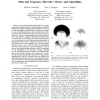Free Online Productivity Tools
i2Speak
i2Symbol
i2OCR
iTex2Img
iWeb2Print
iWeb2Shot
i2Type
iPdf2Split
iPdf2Merge
i2Bopomofo
i2Arabic
i2Style
i2Image
i2PDF
iLatex2Rtf
Sci2ools
ICRA
2008
IEEE
2008
IEEE
Path and trajectory diversity: Theory and algorithms
— We present heuristic algorithms for pruning large sets of candidate paths or trajectories down to smaller subsets that maintain desirable characteristics in terms of overall reachability and path length. Consider the example of a set of candidate paths in an environment that is the result of a forward search tree built over a set of actions or behaviors. The tree is precomputed and stored in memory to be used online to compute collision-free paths from the root of the tree to a particular goal node. In general, such a set of paths may be quite large, growing exponentially in the depth of the search tree. In practice, however, many of these paths may be close together and could be pruned without a loss to the overall problem of path-finding. The best such pruning for a given resulting tree size is the one that maximizes path diversity, which is quantified as the probability of the survival of paths, averaged over all possible obstacle environments. We formalize this notion and pro...
Related Content
| Added | 30 May 2010 |
| Updated | 30 May 2010 |
| Type | Conference |
| Year | 2008 |
| Where | ICRA |
| Authors | Michael S. Branicky, Ross A. Knepper, James J. Kuffner |
Comments (0)

